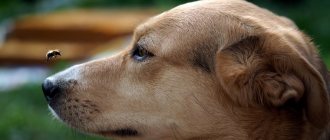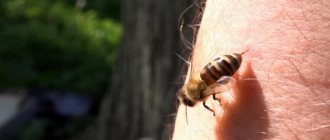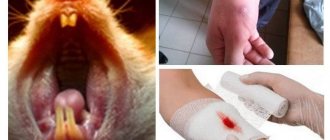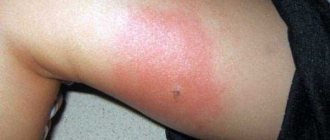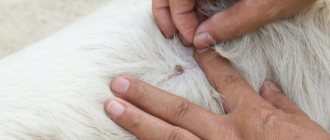With the onset of spring, bees after wintering in hives on sunny days begin to fly around the nearby area, collecting nectar from blooming flowers of plants and trees that secrete nectar.
While walking with dogs and puppies, who sniff almost every flower in the area, it often happens that they are attacked by bees and wasps. At the same time, in dogs, the paws and muzzle most often suffer from bites; a bee and a wasp in a dog can also sting its lips, tongue and even the mucous membrane of the oral cavity (if your friend tries to swallow them).
Danger of bites
A bee or wasp sting is quite dangerous if it is in the face or the pet has swallowed the insect. But if a bee/wasp gets into its paw, then usually no serious consequences occur, apart from intense painful sensations.
Remember that other insects smell the poison and fly to the aid of the attacking individual in order to defend themselves. Such a group looks extremely menacing and can inflict a large number of bites, which is life-threatening.
A bite can result in the following troubles.
Allergies - the dog experiences severe drooling, swelling and itching at the bite site, breathing problems, severe pain, discharge from the nose and eyes, digestive system disorders and even fever.
Choking - when an insect flies into the mouth, it instinctively stings the pet and can get into the tongue, palate or throat, which will lead to swelling and blocking access to air.
Anaphylactic shock is a serious consequence of an allergic reaction. The pet experiences severe swelling of the tissues, breathing is hoarse and intermittent, muscle function is impaired, involuntary urination and vomiting are possible. In this case, you should contact your veterinarian as soon as possible.
A slight swelling and occasional yelping by the dog is a normal reaction to a bite, which can be eliminated at home. For other alarming symptoms, you should immediately go to the doctor.
Treatment in case of angioedema or suffocation
If a bee has bitten a dog not for the first time, then the likelihood of an allergy increases. The severity of the situation will be indicated by the following symptoms:
- labored breathing;
- too much and rapidly increasing swelling;
- blueness of mucous membranes;
- foaming at the mouth or severe vomiting;
- fainting.
In such cases, the animal requires urgent veterinary care. It is possible to cope on your own only if you have medications.
Relieving swelling
Without specific medications, relieving swelling is only possible by eliminating the allergen (stings with poison), then applying a compress and tourniquet above the affected area. It is also recommended to provide your pet with a stable supply of fresh air. After all these steps, you should wait for the doctor or go to the nearest veterinary clinic yourself.
Use of drugs
In case of an acute allergic reaction, drugs are administered intravenously or intramuscularly. Glucocorticosteroids are added to antihistamines, which weaken the immune response. If you know how to give injections and know the list of drugs that are safe for your pet, then do not waste time and administer them yourself.
Visiting a veterinary clinic
If a bee has bitten a puppy or an elderly dog, it is better to go to the veterinary clinic immediately. It is recommended to do the same in case of numerous bites and at the first signs of suffocation.
In addition to the drugs listed above, doctors use adrenaline or epinephrine. They have the following properties:
- relax the muscles of the bronchi and facilitate breathing during an attack;
- block the release of histamine and eliminate inflammation;
- stabilize heartbeat;
- constrict blood vessels.
If intravenous administration is not possible, drugs are administered intratracheally, that is, between the tracheal rings. To do this, step back from the throat to the thickness of your little finger and insert a needle. The rings themselves are easily identified by palpation.
What to do on your own
Bees dig into the body of an animal or person, leaving a sting with jagged edges and a poisonous sac, and sometimes with part of the intestine, so it would be more correct to say “the dog was stung by a bee” rather than bitten. But wasps and hornets can also bite using their powerful jaws. It is necessary to determine which insect attacked the dog; competent assistance and treatment depends on this.
The bee sting remains in the wound, and the insect itself dies. Wasps can easily sting repeatedly, and sometimes they also use their jaws to bite. Their stings are more painful than those of bees.
Working bumblebees have a sting without serrations, which allows them to be used several times. Large hornets also have a smooth sting. In addition, hornets feed on sweet fruits; they gnaw holes in their shells, gradually plunging into the pulp, so a dog can accidentally swallow them together with a piece of delicacy. By the way, this situation can happen to a person.
So, if a dog is stung by a bee, the first thing you need to do is determine the location of the bite and remove the sting. It is advisable to remove it with a sliding movement using a hard object, so as not to crush the bag of poison even more.
It is advisable to rinse the affected area with either plain clean water or a soda solution, calculating one teaspoon per half liter of water. An alkaline solution will reduce the effects of poison containing acid.
If a wasp stings, on the contrary, it is worth preparing a weak solution with lemon juice or apple cider vinegar, since wasp venom contains alkaline components.
So, after the bite site has been washed, you can give the dog an antihistamine (Tavigil, Cetrin, Zyrtec, Suprastin), preferably a special veterinary drug, for example, Allervet, but in an emergency situation, “human” drugs are also allowed. Call your veterinarian for dosage information, but never give your dog an adult dose. For small swellings, tablets are usually sufficient.
Wounds from which the sting has been removed must be treated with hydrogen peroxide or another antibacterial agent.
Apply a cold compress to the bite site for 10-15 minutes. To do this, you can use something frozen from the freezer, just wrap the ice in a towel first.
You shouldn’t overload your dog with food, it’s better to give him more to drink.
Additionally, gels or ointments “Fenistil”, “Lorinden” or hydrocortisone ointment 1% are applied to the affected area; such products will relieve itching and reduce swelling. It would be a good idea to ask your veterinarian in advance during your scheduled visit what items should be in your first aid kit in order to provide first aid in the event of a bite.
Bitten by a wasp (bee): dangerous or not?
An insect bite is always very painful. Further developments depend directly on the dog’s immunity and tendency to express an allergic reaction. In 3-7% of cases, a wasp (bee) sting causes a severe reaction with complications, including death.
Bees rarely attack animals on their own initiative; bites are their natural defensive reaction to a dog’s “interest” in the nest or when a pet accidentally presses an insect. Bees, wasps, and bumblebees really do not like sudden movements, loud sounds, or unpleasant odors.
What to do if an allergic reaction develops
An allergy almost always develops if an insect stings the nose, face, neck and mouth area. Therefore, if such a place is damaged, give the dog an antihistamine.
If your pet has a strong reaction, anaphylactic shock develops. Its symptoms include:
- vomit;
- labored breathing;
- foam at mouth;
- changes in tongue color;
- large swelling at the site of the bite;
- loss of consciousness, etc.
In such a situation, there is no need to panic. Calcium chloride should be introduced into the pet's body; it is better to give an injection, but you can pour the ampoule onto the tongue. A dexamethasone injection will be effective. The dosage of such a medicine is calculated by weight; to combat shock conditions, the medicine is used once in a dose of 1-1.5 ml/kg of the animal’s weight, this is usually 0.5-1 ml. Then immediately take the dog to a doctor to provide qualified assistance.
Dosage of drugs for acute allergies
Note! The drug for injection and its dosage should be prescribed by a specialist. Consult your veterinarian before using them. The figures below are provided for informational purposes only and for single use only – in case of long-term use, significant differences in dosage are possible.
- Suprastin, tavegil and diphenhydramine
: if the pet’s weight is less than 10 kilograms, 0.1 ml of the drug is taken for each kg. For example, with a dog weighing 8 kg, the dose is 0.8 ml. For a dog weighing from 10 to 20 kg, take 1 ml, over 20 kg - 2 ml. - Dexamethasone:
weight less than 10 kg - 0.1 ml per kilogram; from 10 to 30 kg – 1 ml; more than 30 – 2 ml. - Furosemide:
less than 10 kg - 0.1 ml per kilogram of weight, from 10 to 20 - 1 ml, more than 30 - 2 ml. - Magnesia (25 percent solution) –
0.1 ml per kilogram of weight. For example, with a weight of 10 kg - 0.1 ml, 20 kg - 2 ml, from 30 to 40 kilograms - 3 ml, from 40 to 60 - 4 ml.
When to urgently contact a veterinarian
The pet owner should not self-medicate in the following situations:
- If your pet is bitten by several bees or wasps at once;
- If the animal's face is injured or the dog swallows a stinging insect;
- The dog’s health deteriorated and signs of a serious allergy appeared;
- The pet was not healthy even before the bite.
Remember that a harmless bite can cause many unpleasant moments for your dog.
Therefore, try to monitor him more closely after an unpleasant situation and if his condition worsens, do not be afraid to contact a veterinarian. On our website there are more than 3430 veterinary clinics in Moscow for you on our website injections for animals
Prevention
We looked at the symptoms, treatment and prevention if your dog is stung by a wasp or bee. Is there any way to protect your pets from stinging insects? This cannot be done completely. But you can minimize the risks.
You should keep an eye on your pet while walking. Keep it away from flowering plants and berry bushes. This is especially true for active breeds. After all, you can often meet, for example, a curious dachshund that was stung by a bee while out for a walk. But a calmly walking French bulldog rarely becomes a victim of stinging insects.
The walking area should be checked for wasp nests. By following these rules, the number of bites will be kept to a minimum. The dog owner must have a first aid kit containing the medications necessary to provide medical care.
How to protect your pet
In judicial practice, there have been cases when bees bit a dog, and the beekeeper compensated for the damage. During the honey harvest period, insects become aggressive, so the likelihood of getting a bite at this time increases several times. Despite this, preventing a dangerous situation is much easier than demanding moral compensation in court.
First of all, you should evaluate the environment in places where you frequently walk your dog. It is advisable to avoid being near apiaries. It is not recommended to let your pet near berry bushes. If a nest of wild bees is discovered, it is necessary to destroy it using the safest means before the insect has time to bite someone close to you. It is also important to ensure that you have a first aid kit, which you should always take with you on a walk. The life of a pet may depend on the timely provision of first aid.
We are looking for the culprit
It is important to understand who attacked the companion in order to properly provide first aid. Bees have serrations on their sting, so it remains inside along with the poison sac. The insect dies, and the other defenders flock to the smell of the poisonous sting.
Wasps sting more painfully and are able to bite. They have a smooth sting, so insects often attack several times. The same goes for bumblebees and hornets. The latter are more dangerous, as they often get into fruits. A dog may accidentally swallow an insect and be injured.
Pets usually receive one or more bites. Rarely is an animal attacked by a whole swarm. However, in any case, it is important to examine the companion and look for any damage. Bites in the area of the throat, nose, tongue and lips are especially dangerous: swelling of the mucous membrane can cause suffocation.
What not to do
- independently try to bring the dog out of anaphylactic shock, especially if it is accompanied by swelling of the upper respiratory tract;
- treat the bite site with alcohol-containing substances;
- give human antihistamines without consulting a veterinarian (at least by phone), because not all medications are suitable for dogs;
- do not use any essential oils, especially if the bite is on the head - an additional strong smell can increase swelling.
Photos of dogs stung on the nose by bees
Sources
- https://Ros-Vet.ru/koshki/esli-sobaku-pokusala-osa-pervaya-pomoshh/
- https://dezbox.ru/dezinsekciya/chto-delat-esli-sobaku-ukusila-osa/
- https://porodadog.ru/zdorove/prochie-bolezni/sobaku-ukusila-pchela.html
- https://www.pitomec.ru/articles/dogs/health/541
- https://gafki.ru/sobaki/ukusila-osa-v-lapu-ili-mordu.html
- https://ilike.pet/ru/articles/moego-psa-uzhalila-osa-chto-delat-_19/
- https://pesikmal.ru/zdorove/bolezni/pchela.html
[collapse]
Precautionary measures
To protect your pets from bee stings, you should adhere to the following precautions:
- Do not walk near the apiary.
- If you take your pets out of town, take a home first aid kit for your dog with you. It should contain antihistamines.
- Do not allow your dog to walk in flower beds or near flowering bushes, which attract wasps and bees with their color.
- If a bee or wasp has flown into the house, you need to open the window and shoo away the insect with a towel. Animals should be isolated in another room.
- When going outdoors, you should take into account that the smells of perfumes and sweets attract these insects.
- If a pet is taken to the country, you should make sure that there are no nests of wasps or bees on the site. Otherwise, take measures to destroy them.
- If a sting occurs and it is necessary to carry out a painful procedure for removing the sting or an injection, you need to behave confidently and firmly so that the dog feels that you are the leader. Procedures should be carried out quickly. If necessary, use another person to restrain the dog or tie it up.
In most cases, when a dog is stung by a bee, it is enough to treat the sting site, but sometimes an injection is not necessary. During the summer, it is recommended to keep antiallergic drugs in your home medicine cabinet, which can save the animal’s life.

